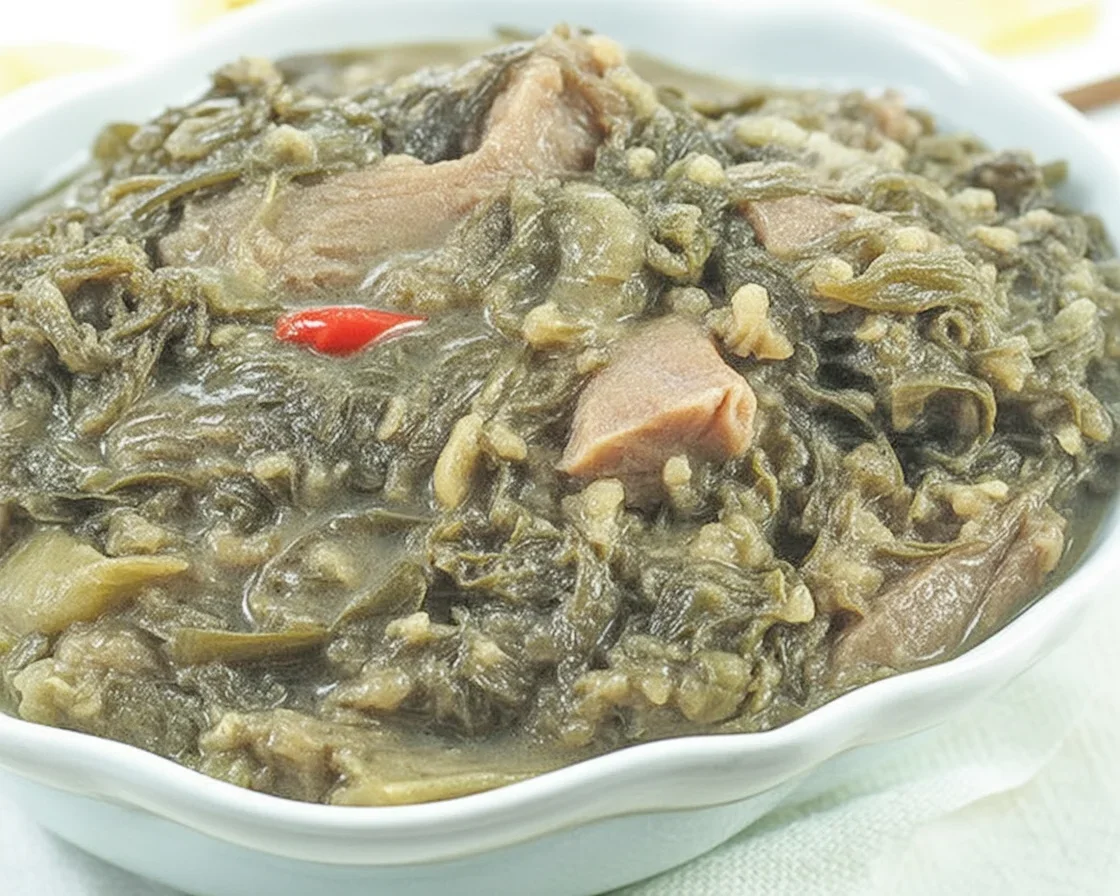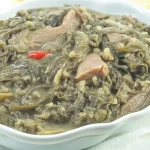- Overview of laing
- Preparing taro leaves
- Cooking in coconut milk
- Adding chili and seasoning
- Serving with rice
- Storage tips
- Regional variations
- Common Questions
- Why you’ll love laing (and gotta try it)
Filipino laing is a lifesaver for those nights when you’re sick of the usual fried stuff, hungry for something with more oomph, but also… not exactly in the mood to spend hours in the kitchen. You ever have those days where you just want a simple, homey meal with a bit of adventure? That craving for coconut milk and spice just won’t go away. I totally get it. Actually, laing is my go-to dish when I need comfort food that isn’t boring—and hey, it’s even somehow healthy-ish. If you want more Filipino classics to mix things up, check out these healthy Filipino recipes or jump to the authentic Bicolano laing recipe if you’re after the OG flavor bomb.

Overview of laing
Alright, here’s the deal. Laing is one of those dishes you either grew up eating or first tried at someone’s family gathering—and then instantly wondered where it’s been all your life. Basically, laing is made from dried taro leaves cooked slowly with coconut milk, all jazzed up with chili and sometimes bits of pork or dried fish for deeper flavor. Super straightforward but bursting with big, bold flavors.
Lot of folks think laing is intimidating. Not really. The hardest part (in my opinion) is just tracking down taro leaves, but Asian markets usually have them—sometimes labeled “gabi leaves”. Once you get the hang of it, you’ll find laing to be surprisingly customizable. Want it spicy? Add more chilies. Want it rich? Heaps of coconut milk to the rescue.
It’s traditional in Bicol (that’s a region in the Philippines known for spicy food), but I swear, everyone’s grandma has their own secret touch. And let’s be real—nothing makes rice disappear faster than laing. Some people even skip the meat, so it’s perfect if you’re plant-based or just want a light dinner. So don’t be shy. Give it a try—you might just join the laing fan club.
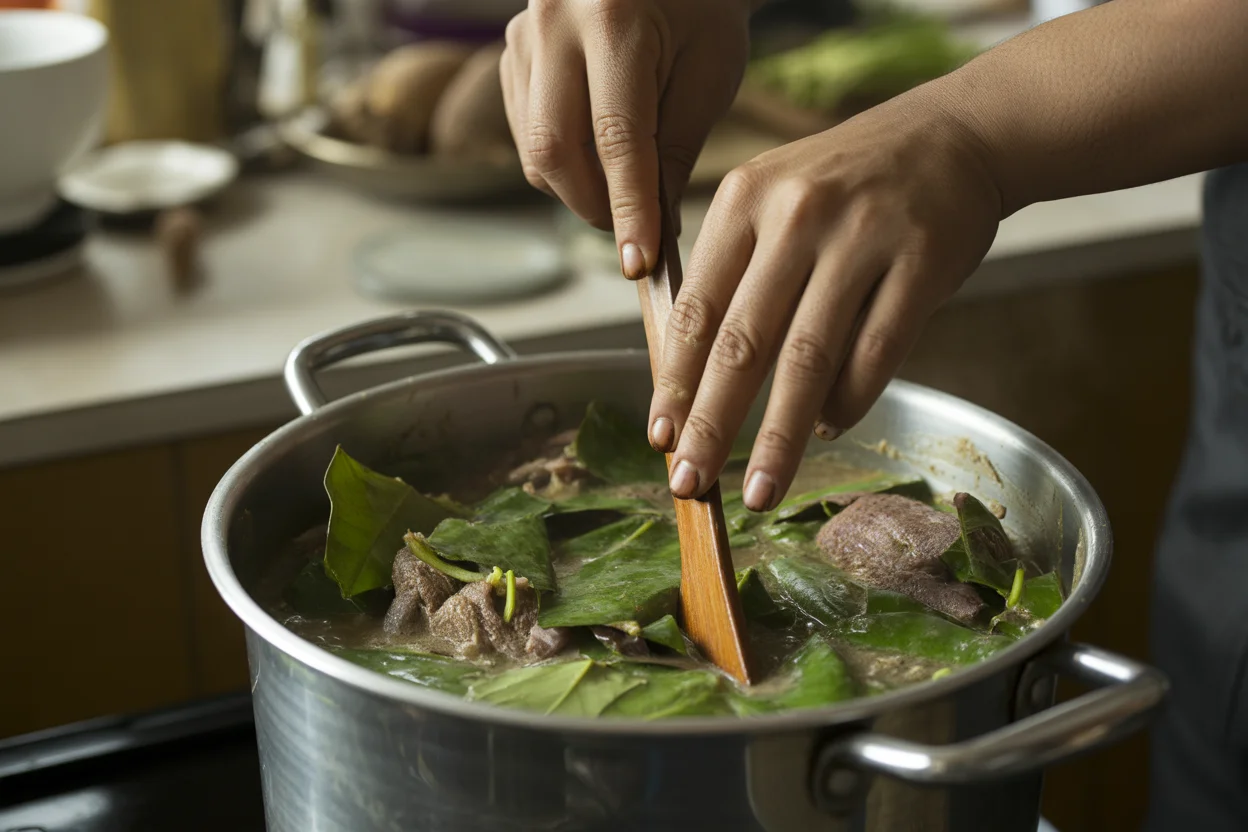
Preparing taro leaves
Okay, let’s talk taro leaves, because this part… can be tricky if you haven’t handled them before. Fresh taro leaves are sometimes available but more often you’ll get dried ones, which is what most Filipino laing recipes use. Here’s my two cents—don’t even think about using frozen spinach or kale for this unless you want a totally different dish (yup, I tried). Dried taro leaves have an earthy, nutty flavor after simmering, and that’s what makes laing, well, laing.
Before you cook, always rinse those leaves gently. If you’re using dried, no need to chop. Just watch for tough veins and toss those out. Also, don’t stir the leaves too much once they’re in the pot or you risk making things slimy. Some people get itchy from raw taro leaves—don’t worry, thorough simmering sorts that out. Tip: If you spot any white spots/powder on them, a gentle rinse usually does the trick. Itchy tongue? It means they needed more cooking, so just let things bubble longer next time.
Basically, prep is way easier than it sounds. Once you’ve done it once, it’ll be second nature. Oh, and don’t forget to grab coconut milk while you’re shopping—can’t skip that!
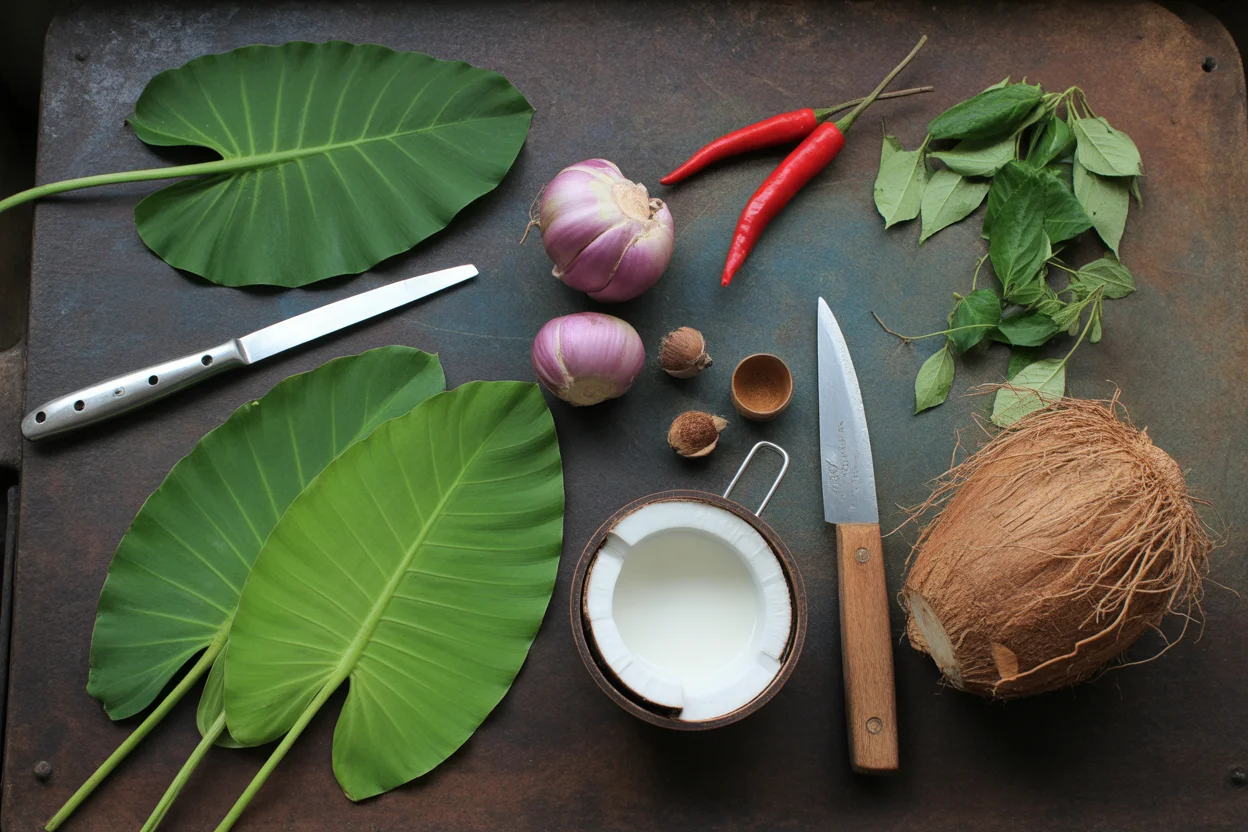
Cooking in coconut milk
Pouring in that coconut milk is the best part. Something about the smell—man, it just transports me back to childhood. Here’s how I do it:
First, start with onions, garlic, a little ginger (guess what, optional, but I love it) sizzling in oil. Next goes the coconut milk—let it come to a bubbly simmer before you even think about adding those taro leaves. Once the leaves go in, just press them down gently with a spatula. Don’t stir. Resist the urge! Stirring makes things gritty.
Once you see the leaves soaking up the coconut milk like little sponges, you know you’re on track. Some old timers cover the pot and let it simmer on low for 40-50 minutes, checking now and then that it doesn’t dry out. If you need to, add a splash more coconut milk or even a bit of water. That’s it. You’ll know it’s done when the leaves are completely soft and the coconut oil starts to separate on top. Magic.
Biggest tip—do not rush. That slow bubbling is what transforms fibrous leaves into something melt-in-your-mouth dreamy. “Laing that’s rushed is laing wasted,” as my Lola used to say. I mean, she knew her stuff.
Adding chili and seasoning
This is where Filipino laing gets its signature kick. But hey, if you’re not a spice fiend, you can totally control the heat. The go-to chilies are the small green or red siling labuyo (bird’s eye chili), but even plain ol’ jalapeño works if you’re in the US. Add the peppers about halfway through cooking—trust me, if you toss ’em too early, they lose their oomph.
For seasoning, fish sauce is classic. Don’t be scared if the kitchen gets a bit fragrant—it evens out in the end. Salt works too if you want to keep things plant-based. Taste it towards the end, then adjust. Add dried shrimp or smoked fish if you want a meaty boost, but honestly, laing is just as good in its humble state.
Oh, and sprinkle in a bit of black pepper before serving for a little extra zing. That’s my personal must-do—it rounds everything out and makes things pop. Honestly, every batch is a new adventure in spice.
“I never thought I’d get addicted to vegetables until I made laing. Even my kids ask for seconds, and that’s almost impossible with greens!” – Pia R., New Jersey
Serving with rice
Here’s where I get downright enthusiastic. Laing and rice—probably the best food combo on planet Earth. The coconut milk sauce kind of seeps into the rice, and BOOM, plain white rice suddenly feels fancy. Here are my top serving suggestions:
- Perfect with just steamed jasmine rice. Nothing else needed.
- For a fun twist, serve it with garlic sinangag and fried egg.
- Add a side of fried fish or bistek Tagalog for a real Filipino feast.
If you’re meal prepping, laing keeps really well, so double up and stash some for tomorrow. Trust me, it tastes even better the next day—if there’s any left.
Storage tips
Let’s get real: leftover Filipino laing is almost mythical in my house. But on the off chance you do have some left, storing’s a breeze. Let it cool to room temp, pop it in an airtight container, and refrigerate. I find it lasts about three days before the flavor gets, I dunno, a little tired. Coconut milk dishes tend to get richer after resting, so don’t be surprised if it’s even tastier.
Freezing? Totally doable. Just portion out single servings, then thaw and reheat in a saucepan with a splash of water or coconut milk to loosen it up. Don’t microwave it too long, or you’ll end up with a mushy mess. Nobody wants sad laing, right?
If it’s a bit oily on top after chilling, that’s normal. Just stir it all together before serving.
Regional variations
Here’s the fun bit. Filipino laing is all about customization. In Bicol, lots of folks stir in dried fish or pork belly for smoky depth. Some recipes add sweet potato leaves or sliced bamboo shoots. In Metro Manila, most stick to pure taro leaves. My friend from Laguna even throws in chili leaves (talk about spicy), while another swears by dried shrimp for extra umami. So yeah, there’s no official version—just endless riffs.
If you wanna keep things simple, you do you. Want it vegetarian? Leave out the fish. More coconut milk? Go for it. Spicier? Toss in more peppers. It’s almost impossible to mess up once you get the basics right.
This dish proves Filipino cooking isn’t just about recipes—it’s about what you’ve got, what you like, and a little bit of tradition thrown in.
Common Questions
Q: Can I use fresh taro leaves instead of dried?
A: Absolutely, just make sure to simmer them longer so they’re not itchy.
Q: Is laing always spicy?
A: Nope. You control the heat. Just dial back on the chilies for a mild version.
Q: Can I make this vegan?
A: For sure. Just use salt instead of fish sauce and skip any dried seafood or meat.
Q: What else can I do with leftover Filipino laing?
A: Stir it into scrambled eggs, stuff it into bread, or even use it as a pasta sauce. Creativity wins!
Q: Coconut milk keeps splitting—am I doing something wrong?
A: Not really! Sometimes this happens when simmering for a long time, but it’s totally normal and even adds to the flavor.
Why you’ll love laing (and gotta try it)
Laing is honestly the comfort food you didn’t know you needed. With coconut milk, taro leaves, and just the right kick of chili, it’s simple, customizable, and impossible not to love on a rainy night. Filipino laing is as fun to make as it is to eat, and it brings serious home-cooked vibes to any weeknight dinner. If you want more recipes, I highly suggest checking out the Panlasang Pinoy laing recipe for a classic take, read up on what laing is, or try the twisty ginataang laing version for a new spin. Don’t wait for your next party or holiday—grab those taro leaves and let your home kitchen travel to the Philippines, even if just for one meal.
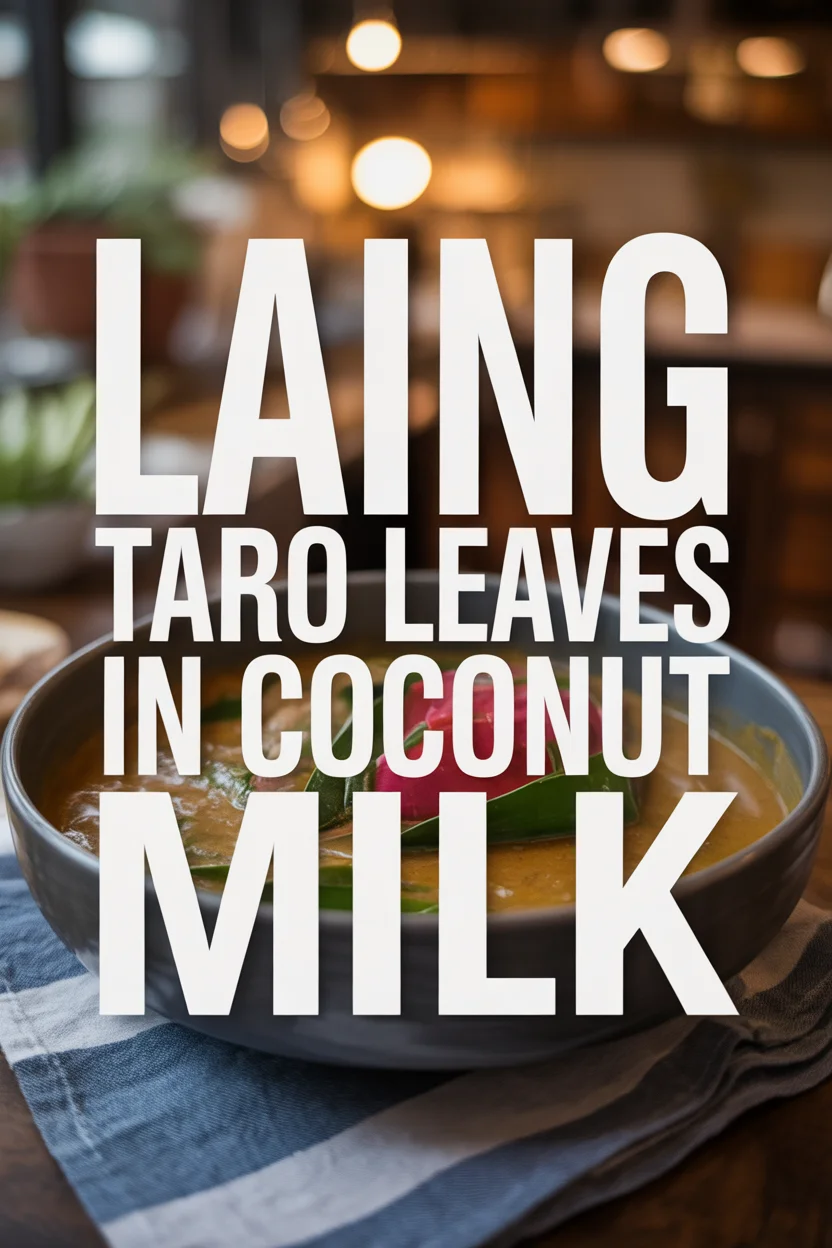
Laing
Ingredients
Main Ingredients
- 10 pieces dried taro leaves Use fresh if available but ensure to simmer longer.
- 2 cups coconut milk Essential for the rich flavor.
- 1 medium onion Chopped.
- 4 cloves garlic Minced.
- 1 inch ginger Optional, but adds flavor.
Seasoning
- 2 tablespoons fish sauce For a salty, umami flavor.
- 1 teaspoon black pepper Add for extra spice.
- to taste chili peppers Use siling labuyo for authentic heat.
Instructions
Preparation
- Rinse dried taro leaves gently and remove tough veins.
- Prepare the ingredients by chopping onion, garlic, and ginger.
Cooking
- Heat oil in a pot and sauté onion, garlic, and ginger until fragrant.
- Add coconut milk and bring to a simmer.
- Gently press in the taro leaves without stirring too much.
- Cover and let simmer on low heat for 40-50 minutes, adding water or more coconut milk as needed.
- Check that the leaves are soft and the coconut oil has separated on top.
Finishing Touches
- Add chili peppers and fish sauce halfway through cooking, then adjust seasoning to taste.
- Before serving, sprinkle with black pepper.
Serving
- Serve laing with steamed jasmine rice or garlic sinangag.
- Pair with sides like fried fish or bistek Tagalog for a complete meal.
